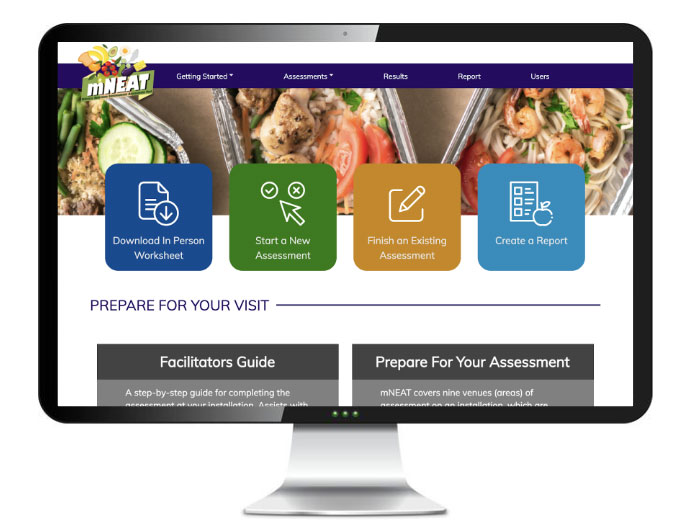History of mNEAT
The Military Nutrition Environment Assessment Tool (mNEAT) is the first DoD standardized tool to assess the food environment in unique military settings. Initially developed in 2011 by a joint-service work group, mNEAT version 1.0 was adapted for the military from the Michigan Nutrition Environment Assessment Tool and the Nutrition Environment Measures Survey from Emory University. In 2015, mNEAT 2.0 was updated and developed into a spreadsheet. mNEAT has evolved with the number and types of venues assessed, number and content of questions, key categories, and scoring modifications to more accurately reflect the types of food service provided at different venues. The tool was refined based on pilot projects (DoD’s Healthy Base Initiative and Healthy Army Communities) and military nutrition community stakeholder input, including food service operators.

From 2020–2021, the Military Nutrition Environment Working Group (MNEWG) created a web-based version of mNEAT (mNEAT 3.0). The update incorporates DoD policy, federal food service guidelines, and assessment-based action plan guidance. There are nine venue types to assess.
- Commissary
- Express shop or grab-n-go
- Morale, Welfare, & Recreation eating venues
- Fast food
- Food truck
- Dining facility or galley
- Vending levels 1 & 2
- Worksite
- Community
Each branch completes the same assessments of their nutrition environment with service-specific guidance and policies for the mNEAT process.
Why conduct a nutrition environment assessment?
The purpose of mNEAT is to systematically assess a military installation or ship’s food environment. By reviewing the availability, access, promotion, and policies related to health- and performance-based eating, you can learn about your local nutrition landscape. Annual mNEAT assessments also help to establish a baseline for your installation or ship, identify wins, and determine areas of opportunity for improvement. In addition, mNEAT results can help facilitate engagement and collaboration with community stakeholders (food service operators, health promotion team members, and leadership) to optimize the nutritional fitness of the local military community.
Keep in mind that mNEAT is a tool, and change doesn’t happen without follow-up action. Conducting mNEAT helps to support the development of action plans to improve the nutrition environment and enhance the mission of Service Members. When you build a team, set up a clear process, and involve key stakeholders for optimal collaboration, your activities can become more sustainable. This will help impact the health and wellness of Service Members for years to come.
Impact on the military community
mNEAT helps stakeholders and leaders understand the local installation or ship’s nutrition environment, including food policy, food availability, and behavioral design in a variety of food service venues. Results can help describe existing nutrition environment conditions and policies among the local military community, branch, and the larger DoD. One of the five pillars of the White House National Strategy on Hunger, Nutrition, and Health is to “empower all consumers to make and have access to healthy choices.” Overarching strategies include accessible food labeling, healthier food environments, and a more nutritious food supply, so the healthier choice is the easier choice. Specifically, the plan outlines expanding access to healthier food environments in federal facilities.
“Diets of military personnel worldwide are characterized by an insufficient intake of nutrient-rich, health-promoting foods—such as fruits, vegetables and whole grains—and an excess intake of less-healthy food components such as refined grains and saturated fats. These patterns have been apparent over the past decade, and may be exacerbated by military environments that encourage undesirable eating behaviors.”
—Karl et al., 2021
An installation that supports a performance-based eating environment benefits the nutritional fitness of all members of the military community. A focus on nutritious food options through environmental changes and policy can optimize health, performance, and readiness.
